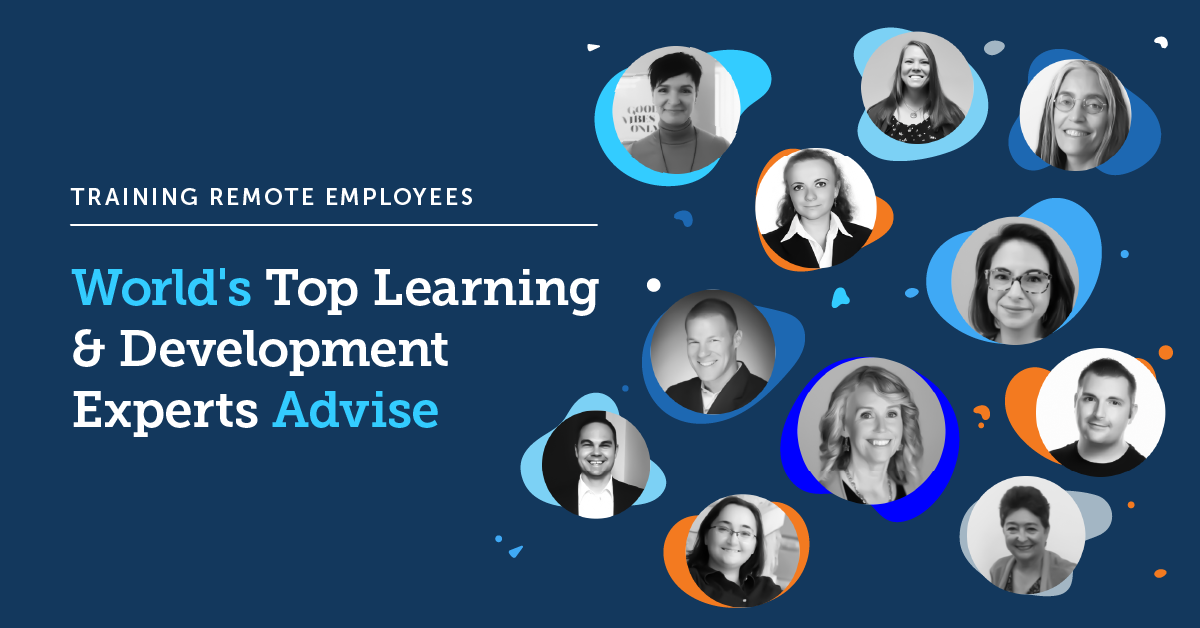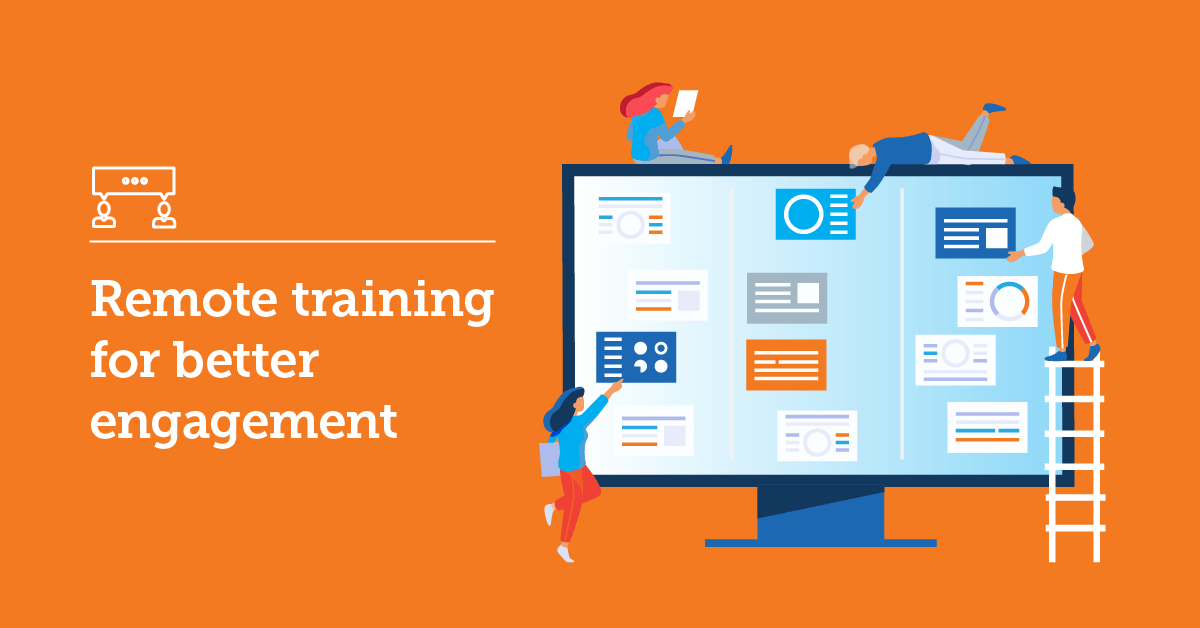In a world of constant flux, the only certainty is change. Sometimes it comes slowly and steadily, while other times — as we’re experiencing right now — everything can change in the flick of a switch.
With workplace rules being reshaped and remote work becoming the new normal, professionals need to adapt to these new circumstances. To stay afloat and reach their usual productivity, they need additional resources which’ll help them navigate a remote work setting.
A recent survey by TalentLMS found that 7 in 10 remote workers need more training from their companies. So, to help their distributed workforce keep up and thrive in times of uncertainty, companies need to provide thoughtful and engaging training.
And now comes the best part.
We curated a list with the most influential learning and development experts worldwide. Whether instructional designers, learning architects, or LX designers, they’re the workplace learning specialists; training adults online is in their wheelhouse. So, we asked them for actionable advice and practical tips on how companies can make the most out of their remote training.
If you want your remote employees to get engaged, learn better, and remember longer, hear their advice.
Connie Malamed — Let people shine by helping them become self-directed learners
Tim Slade — Don’t try to recreate the in-person experience in an online environment
Stella Collins — Imagine your learning audience and ‘talk’ to them as if you’re together
Brian Washburn — Ask questions and run online polls
Ashley Chiasson — Chunk learning into small pieces
Crystal Warren — Create a “micro lessons” library
Christy Tucker — Use scenarios with characters your learners can relate to
Anna Sabramowicz — Engage learners with a story and let them influence its outcome
Travis Jordan — Practice makes perfect
Allison Rossett — Give learners guidance on what to do and how to do it
Marina Arshavskiy — Use quizzes, exercises, group discussions, and real-life simulation
Help people become self-directed learners
Connie Malamed from theelearningcoach.com
 A real superstar of the online learning community, Connie is a learning experience design consultant. She’s a prolific writer and speaker in the fields of online learning, visual communication, and information design.
A real superstar of the online learning community, Connie is a learning experience design consultant. She’s a prolific writer and speaker in the fields of online learning, visual communication, and information design.
Connie has been helping organizations create meaningful learning experiences for over two decades. She has written two books, Visual Design Solutions and Visual Language for Designers, and is the creator of The eLearning Coach podcast. She’s an advocate of a “pull” rather than a “push” learning model, and enjoys empowering people with the tools they need to become self-directed learners.
We asked Connie about what organizations can do to make learning in the workplace better, and how to engage their remote workforce. This is her advice:
When it comes to learning, less is always more
People can only process around 3-4 bits of information at one time. This means fire hose training and information dumps actually detract from learning. When it comes to learning, less is always more. Therefore, focus on what is most important to learn and practice. Provide what is “nice to know” as optional outside resources.
Create a learning journey rather than a one-time intervention
A second principle is to space out learning. Think of it in terms of a learning journey rather than a one-time intervention. Ensure there is sufficient opportunity for staff to practice and to get feedback. Provide opportunities for learners to discuss challenges and issues and to learn from each other. Promote mentoring opportunities. By focusing on the development of key skills over time and in different ways, you will help people build long-term capabilities.
Don’t try to recreate the in-person experience
Tim Slade from timslade.com
 Whether he talks about eLearning scenarios or the best Thanksgiving turkey recipes, Tim has an extraordinary knack for engaging people. He’s an award-winning freelance eLearning designer, speaker, and author.
Whether he talks about eLearning scenarios or the best Thanksgiving turkey recipes, Tim has an extraordinary knack for engaging people. He’s an award-winning freelance eLearning designer, speaker, and author.
Tim believes that creating a successful eLearning course doesn’t stop with good instructional content. That’s why he’s devoted to creating beautiful eLearning experiences and shows us how we can do it, too, on his YouTube channel.
Here’s what Tim’s told us about achieving a smooth transition to remote online training:
Break your content into multiple, shorter sessions and aim for a blended solution
When you’re looking to transition your in-person training for online delivery, there are a few [things] you can do to do it right. First, don’t try to recreate the in-person experience in an online environment. Take the time to re-think your activities and content, and make the necessary changes to take advantage of the online environment.
Second, break your content into multiple, shorter sessions–no one wants to sit through an eight-hour webinar.
Third and finally, explore alternatives to create a blended solution. Where possible, look for opportunities to create a short video, a job aid, or an interactive eLearning course.
If you’re looking to create interactive courses online, you’ve come to the right place.
Create your free account to build, track, and deliver your training with the easiest-to-use LMS.
Imagine your learning audience is next to you
Stella Collins from stellarlabs.eu
 “There’s no such thing as a boring topic – just boring training”, is Stella’s moto.
“There’s no such thing as a boring topic – just boring training”, is Stella’s moto.
Stella is an educator, author, and consultant who specializes in applying neuroscience and psychology to learning and development. She’s the cofounder and chief learning officer at Stellar Labs.
As a child, Stella wanted to be a fashion designer. But instead, she found her way into learning and development, where she has been working for the last two decades.
Here’s an advice from this talented “Brain Lady” on how to make your online course more engaging:
“Talk” to your learning audience as if you’re together
Whether you’re live or recording online content, there are real live people at the other end of the connection, and their brains need to work to learn.
Imagine your audience and ‘talk’ to them as if you’re together. If you don’t know them, create a persona and believe in it. Have a personal conversation and see the world through their eyes. Use ‘you’ rather than ‘I’ or ‘we’ and rich, sensory language to paint a picture.
Encourage guessing before you tell because it improves memory
Imagine and address their motivations, provide the big picture before diving into detail. Encourage participation early and regularly and promote contribution and collaboration. Link to what people already know and encourage guessing before you tell because it improves memory. Design in practice, feedback and testing. Create deductive questions so people have to work out the answer. Build in spaced repetition rather than one-off activities.
Ask questions and run online polls
Brian Washburn from trainlikeachampion.blog
 In a poll that Brian recently ran on his blog, he found that 1 in 2 learning professionals is shaky when delivering virtual training. And he made it his mission to change this. He devoted his career to provide other trainers with guidance and tools that’ll help them thrive and train like champions.
In a poll that Brian recently ran on his blog, he found that 1 in 2 learning professionals is shaky when delivering virtual training. And he made it his mission to change this. He devoted his career to provide other trainers with guidance and tools that’ll help them thrive and train like champions.
In his work, Brian brings his two passions together: devotion to high performance and result-oriented training with his love for sports. His training programs have helped various organizations, from Fortune 500 companies to NGOs, achieve their learning goals and thrive. He’s also the creator of L&D podcast Train Like You Listen, where he shares the latest insights about engagement, workplace learning, remote training, and new technologies.
Here’s Brian’s advice for engaging virtual training:
You can make your virtual training engaging without being a master at using breakout rooms
If you’d like to make your virtual delivery engaging, you don’t need to be a master at using breakout rooms (though they are pretty cool) or other advanced features. Keep your delivery engaging, yet simple, by remembering:
1) What people see on the screen matters. Make your visuals engaging by avoiding common PowerPoint design mistakes (check out Jesse Desjardin’s Slideshare deck titled: You Suck at PowerPoint).
2) You’re not stuck with PowerPoint. You can walk people through documents, policies, technical drawings, web sites, spreadsheets or other media by sharing your screen.
3) Don’t just talk to people. Involve them by asking questions and allowing people to vote (using polling) or to discuss via voice or the chat feature.”
Chunk learning into small pieces
Ashley Chiasson from ashleychiasson.com
 Ashley loves working in L&D because she can wear many different hats. On Monday, she might be developing a university graduate course, while on Thursday she could be working on a training aid to illustrate alternating and direct current flow for an aircraft. She knows the ins and outs of turning complex content into engaging learning material.
Ashley loves working in L&D because she can wear many different hats. On Monday, she might be developing a university graduate course, while on Thursday she could be working on a training aid to illustrate alternating and direct current flow for an aircraft. She knows the ins and outs of turning complex content into engaging learning material.
This award-winning eLearning developer is a long-time remote worker, conquering the L&D world from her cozy home office. Even after almost a decade as an instructional designer, a lot of people still scratch their head when she tells them what she does for a living.
When it comes to engaging learners in online training, here’s what Ashley advises:
Avoid overloading your learner with too much information
Chunk the learning at appropriate intervals. What do I mean by this? Well, chunking allows you to take more complex information and break it into smaller, more palatable pieces of information.
While at face value this tip doesn’t sound too engaging, chunking allows you to avoid overloading your learner with too much information before they fully understand the smaller pieces. Furthermore, it allows your learners a better chance of processing and understanding the information that you’re presenting them with.
In short: break each concept down into their smaller parts (or chunks) and teach each chunk until you reach the greater whole so that learners can fully learn the concept you are teaching them. Another way of looking at it — it’s about separating the nice to know from the need to know.
Create a ‘micro lessons’ library
Crystal Warren from designingdigitally.com
 Crystal is an Instructional Designer at Designing Digitally, an award-winning L&D company. This small but powerful team builds creative training solutions for multiple platforms and formats — from simulation training for the state-of-the-art sandwich-making process, to a microlearning solution for a drug-and-alcohol awareness course, to augmented and virtual reality experiences.
Crystal is an Instructional Designer at Designing Digitally, an award-winning L&D company. This small but powerful team builds creative training solutions for multiple platforms and formats — from simulation training for the state-of-the-art sandwich-making process, to a microlearning solution for a drug-and-alcohol awareness course, to augmented and virtual reality experiences.
An artistic nature who spends weekends painting in her studio, Crystal enjoys the creative freedom that instructional design offers.
This is her tip on making the most out of your remote training:
Micro lessons: brief, concentrated courses on a single topic that should take no longer than 5 minutes to complete
With remote access to learning becoming increasingly valuable, a carefully curated micro lesson library is an asset for any company with training needs.
Micro lessons are brief, concentrated courses on a single topic that should take no longer than 5 minutes to complete. Each lesson is hyper focused and is presented in an easily digestible format that serves as a just-in-time resource for any employee who needs timely and time-sensitive resources to effectively complete their job, or appropriately utilize brief windows of down-time at work.
Use scenarios with characters
Christy Tucker from christytuckerlearning.com
 Christy is a sci-fi & fantasy geek and a serial Dungeons and Dragons player who helps companies avoid the monotonous “click next” eLearning approach. She’s a learning experience design consultant with the mission to create engaging learning experiences that stick.
Christy is a sci-fi & fantasy geek and a serial Dungeons and Dragons player who helps companies avoid the monotonous “click next” eLearning approach. She’s a learning experience design consultant with the mission to create engaging learning experiences that stick.
She started out as a teacher and trainer, used to teach music, and has worked with universities and companies such as Cisco and Accenture before stepping “behind the scenes.”
Here’s Christy’s tip for non-boring, engaging employee training:
Alongside behavioral engagement, think about cognitive and emotional engagement, too
eLearning often focuses primarily on behavioral engagement (the actions or clicks people complete). However, just clicking isn’t enough to fully engage people in training. Think about cognitive and emotional engagement too. Give learners challenges that make them think. If they have opportunities to apply knowledge in a relevant context, they’ll be more cognitively engaged (thinking more deeply, rather than just remembering).
Use scenarios with characters who face the same kinds of problems employees do
Using scenarios can provide the context for practicing making the kinds of decisions [employees] have to use on the job. If the scenario has relatable characters and conflict, it also provides emotional engagement. Learners care more about training when they see characters who are like them and who face the same kinds of problems they do on the job. Even short, one-question scenarios can make training more engaging.
Your search for the best LMS ends here!
Stop worrying about costs, IT skills, and missing features. Unlock your team’s potential with the best online training platform.
Sell the learning “journey”
Anna Sabramowicz from elearningsecrets.com
 Adidas, Michelin, Sony, and Harvard are only a few of the well-known companies and institutions associated with Anna’s success story. She’s a powerhouse coach for learning pros and expert in crafting interactive stories. Her superpower is the rare ability to make subject matter experts spill out their juicy stories quickly.
Adidas, Michelin, Sony, and Harvard are only a few of the well-known companies and institutions associated with Anna’s success story. She’s a powerhouse coach for learning pros and expert in crafting interactive stories. Her superpower is the rare ability to make subject matter experts spill out their juicy stories quickly.
Anna’s work revolves around designing and deconstructing what makes an engaging online scenario experience. She also runs the YouTube channel eLearner Engaged and the eLearning Scenario Design Podcast, sharing spunky advice and strategies on how to design interactive experiences.
This is what Anna has to say about making your online course more engaging:
Engage your learners by selling the “journey”
What would a great car salesperson do? Well, before showing you any specs they’d paint you a picture of what owning that car is like. The price is nothing compared to knowing your family’s safe, or your boss is green with envy!
A great sales person tells you about Jim, who also wanted this car, didn’t think he could afford it. But, with perseverance and creative financing, Jim was able to bring it home to surprise his wife.
What does this have to do with learning? Simply this. Learning is difficult. It forces me out of my comfort zone. Sell me on that journey.
How?
Engage me with a story and let me influence its outcome. My reward for being brave enough to jump all in. Show me the future that could be mine. Whatever resource you show me next, I’ll be excited to learn from it.
Make them practice
Travis Jordan from instructionaldesigncentral.com
 Travis created the Instructional Design Central website as a student, in 2006. He wanted to help other students and upcoming professionals learn more about the industry, connect with others, and discover useful resources, tools, and content.
Travis created the Instructional Design Central website as a student, in 2006. He wanted to help other students and upcoming professionals learn more about the industry, connect with others, and discover useful resources, tools, and content.
And over the years, IDC grew into a community that connects more than 18,000 learning and development professionals around the globe.
Travis has 15 years of experience in the learning industry, during which time he has helped various organizations achieve their learning goals.
Here’s his tip on how to secure better knowledge retention:
Retention is more likely when knowledge is applied in a real-world environment
Learning improves when new knowledge is applied by the learner. Retention is more likely when knowledge is applied (or practiced), in a real world environment. In other words, a quiz doesn’t cut it! After all, when was the last time you completed a quiz as a part of your job duties?
You may consider a simulation that mimics real job tasks and activities. You may also consider on the job practice with observation and feedback from a coach. The point is, make your practice as real as possible and knowledge will be retained and transferred.
Guide learners all the way
Dr. Allison Rossett from allisonrossett.com
 Dr. Allison Rossett is a native New Yorker, an ex ping-pong champion and yo-yo’er in training. She’s an educator who’s been consulting organizations such as IBM, the US Army, HP, Deloitte, and the Royal Bank of Scotland, throughout her impressive career.
Dr. Allison Rossett is a native New Yorker, an ex ping-pong champion and yo-yo’er in training. She’s an educator who’s been consulting organizations such as IBM, the US Army, HP, Deloitte, and the Royal Bank of Scotland, throughout her impressive career.
Allison is the award-winning author of six books and multiple white papers on training, learner engagement, and blended learning. Recently retired after many years as Professor of Educational Technology at the San Diego State University, Allison is now a consultant in learning and technology.
Here’s Alison’s advice on engaging learners in online training, no matter if they are third-graders, sales professionals, or nursing students:
Provide guidance: Learners require clarity about how to go forward and how they are progressing
Learners require clarity about how to go forward and how they are progressing. So many programs let them find their way. They lose confidence, and then motivation. They’re gone.
That’s why, early on, the learning material must show that it “gets” the learners. It knows who they are, what they need. The goals of the effort are clear. The approach features useful challenges, tasks and priorities. Learners are asked to be active in authentic ways. Learners have guidance on what to do and how to do it. No flopping around. When they do this, they are likely to experience the pleasure of success.
Use quizzes, exercises, group discussions, and real-life simulation
Marina Arshavskiy from yourelearningworld.com
 Marina is an award-winning instructional designer with the superpower to turn a bland course into the ultimate addiction for the learners. She has a knack for transforming complex ideas into easy-to-follow, step-by-step processes.
Marina is an award-winning instructional designer with the superpower to turn a bland course into the ultimate addiction for the learners. She has a knack for transforming complex ideas into easy-to-follow, step-by-step processes.
With her course designs winning multiple awards, Marina’s one of the eLearning experts who’ve been in the training and learning field for more than 15 years. She wrote a book which explains what is and how to leverage instructional design in eLearning.
Marina shared with us her recommendation on how to maximize knowledge retention in online learning:
Provide your learners with a “What’s in it for me” element
eLearning without retention means nothing. It is our job, as Instructional Designers, to help learners maximize knowledge retention.
We should get learners to actively participate in learning activities by using quizzes, exercises, group discussions, and real-life simulation. Always stimulate multiple senses and remember that learners are going to be looking for the “What’s in it for me” element. Maximize your focus, optimize your time, tweak your mindset and always stay positive.”


![COVID-19: Resources for Working From Home & Training Remotely [Free Courses + Templates]](https://images.www.talentlms.com/blog/wp-content/uploads/2020/03/Working-Training-Remotely-Resources-TalentLMS.png)

